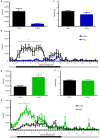Activity of D1/2 Receptor Expressing Neurons in the Nucleus Accumbens Regulates Running, Locomotion, and Food Intake
- PMID: 27147989
- PMCID: PMC4828436
- DOI: 10.3389/fnbeh.2016.00066
Activity of D1/2 Receptor Expressing Neurons in the Nucleus Accumbens Regulates Running, Locomotion, and Food Intake
Abstract
While weight gain is clearly promoted by excessive energy intake and reduced expenditure, the underlying neural mechanisms of energy balance remain unclear. The nucleus accumbens (NAc) is one brain region that has received attention for its role in the regulation of energy balance; its D1 and D2 receptor containing neurons have distinct functions in regulating reward behavior and require further examination. The goal of the present study is to investigate how activation and inhibition of D1 and D2 neurons in the NAc influences behaviors related to energy intake and expenditure. Specific manipulation of D1 vs. D2 neurons was done in both low expenditure and high expenditure (wheel running) conditions to assess behavioral effects in these different states. Direct control of neural activity was achieved using a designer receptors exclusively activated by designer drugs (DREADD) strategy. Activation of NAc D1 neurons increased food intake, wheel running and locomotor activity. In contrast, activation of D2 neurons in the NAc reduced running and locomotion while D2 neuron inhibition had opposite effects. These results highlight the importance of considering both intake and expenditure in the analysis of D1 and D2 neuronal manipulations. Moreover, the behavioral outcomes from NAc D1 neuronal manipulations depend upon the activity state of the animals (wheel running vs. non-running). The data support and complement the hypothesis of specific NAc dopamine pathways facilitating energy expenditure and suggest a potential strategy for human weight control.
Keywords: designer receptors exclusively activated by designer drugs (DREADD); energy expenditure; exercise; food intake; locomotion; medium spiny neurons; nucleus accumbens; running.
Figures






Similar articles
-
Nucleus accumbens D1- and D2-expressing neurons control the balance between feeding and activity-mediated energy expenditure.Nat Commun. 2024 Mar 21;15(1):2543. doi: 10.1038/s41467-024-46874-9. Nat Commun. 2024. PMID: 38514654 Free PMC article.
-
Hippocampal-Evoked Feedforward Inhibition in the Nucleus Accumbens.J Neurosci. 2018 Oct 17;38(42):9091-9104. doi: 10.1523/JNEUROSCI.1971-18.2018. Epub 2018 Sep 5. J Neurosci. 2018. PMID: 30185462 Free PMC article.
-
Nucleus Accumbens D1 Receptor-Expressing Spiny Projection Neurons Control Food Motivation and Obesity.Biol Psychiatry. 2023 Mar 15;93(6):512-523. doi: 10.1016/j.biopsych.2022.10.003. Epub 2022 Oct 21. Biol Psychiatry. 2023. PMID: 36494220
-
Neural mechanisms of the nucleus accumbens circuit in reward and aversive learning.Neurosci Res. 2016 Jul;108:1-5. doi: 10.1016/j.neures.2016.01.004. Epub 2016 Jan 28. Neurosci Res. 2016. PMID: 26827817 Review.
-
Reappraising striatal D1- and D2-neurons in reward and aversion.Neurosci Biobehav Rev. 2016 Sep;68:370-386. doi: 10.1016/j.neubiorev.2016.05.021. Epub 2016 May 24. Neurosci Biobehav Rev. 2016. PMID: 27235078 Review.
Cited by
-
Physical Activity and Brain Health.Genes (Basel). 2019 Sep 17;10(9):720. doi: 10.3390/genes10090720. Genes (Basel). 2019. PMID: 31533339 Free PMC article. Review.
-
Allosteric Modulation of Adenosine A2A Receptors as a New Therapeutic Avenue.Int J Mol Sci. 2022 Feb 14;23(4):2101. doi: 10.3390/ijms23042101. Int J Mol Sci. 2022. PMID: 35216213 Free PMC article. Review.
-
Unlucky punches: the vulnerability-stress model for the development of impulse control disorders in Parkinson's disease.NPJ Parkinsons Dis. 2021 Dec 8;7(1):112. doi: 10.1038/s41531-021-00253-z. NPJ Parkinsons Dis. 2021. PMID: 34880241 Free PMC article. Review.
-
Changes in nucleus accumbens gene expression accompany sex-specific suppression of spontaneous physical activity in aromatase knockout mice.Horm Behav. 2020 May;121:104719. doi: 10.1016/j.yhbeh.2020.104719. Epub 2020 Feb 29. Horm Behav. 2020. PMID: 32081742 Free PMC article.
-
Local accumbens in vivo imaging during deep brain stimulation reveals a strategy-dependent amelioration of hedonic feeding.Proc Natl Acad Sci U S A. 2022 Jan 4;119(1):e2109269118. doi: 10.1073/pnas.2109269118. Proc Natl Acad Sci U S A. 2022. PMID: 34921100 Free PMC article.
References
LinkOut - more resources
Full Text Sources
Other Literature Sources
Molecular Biology Databases

